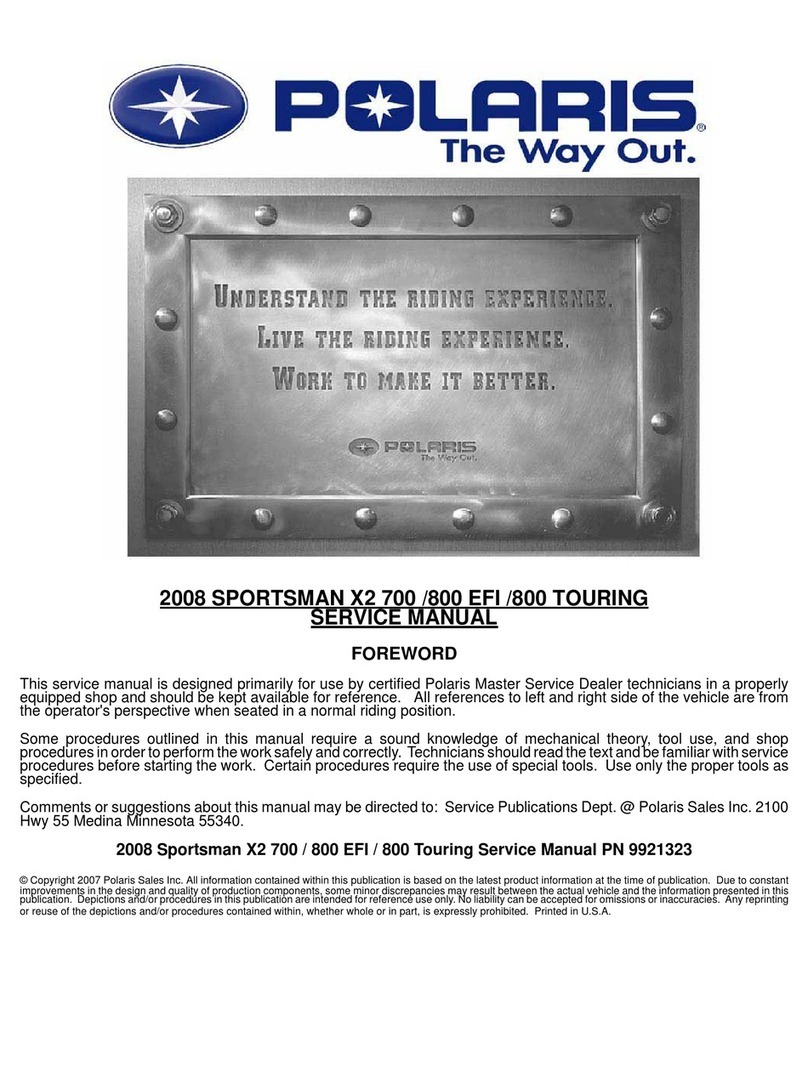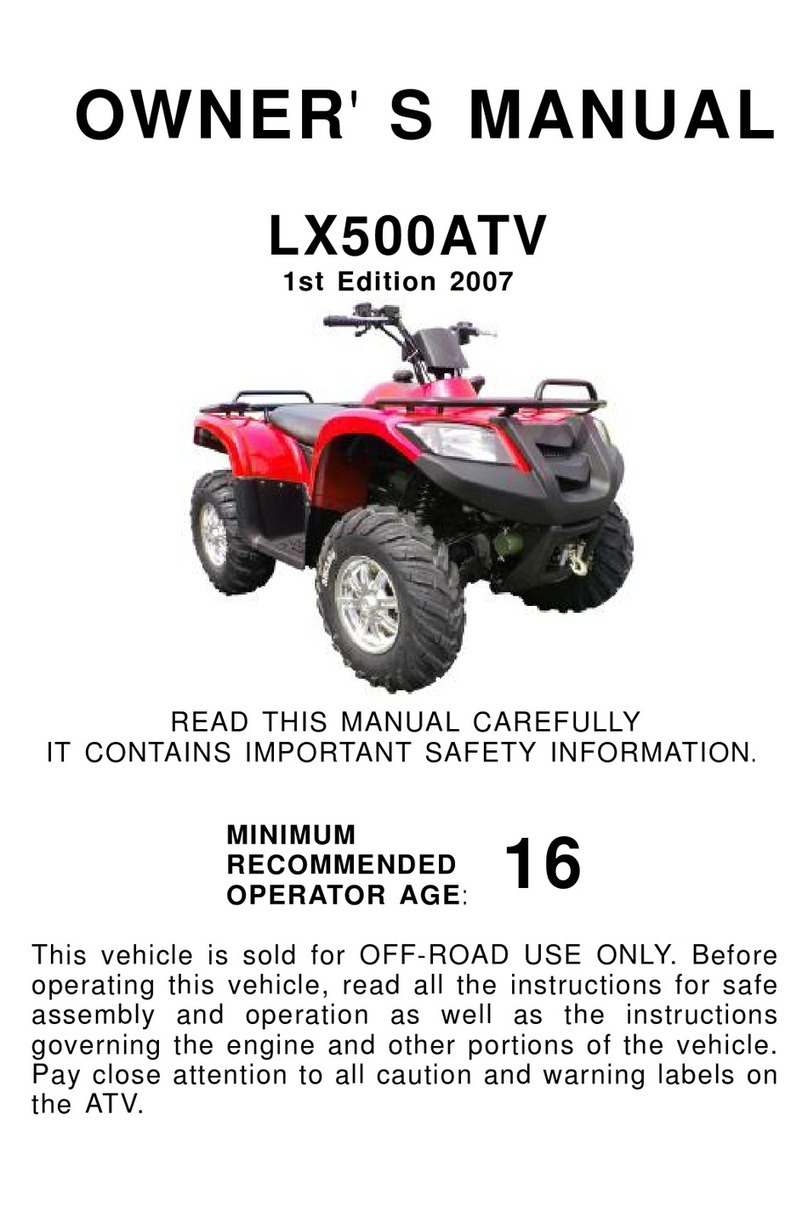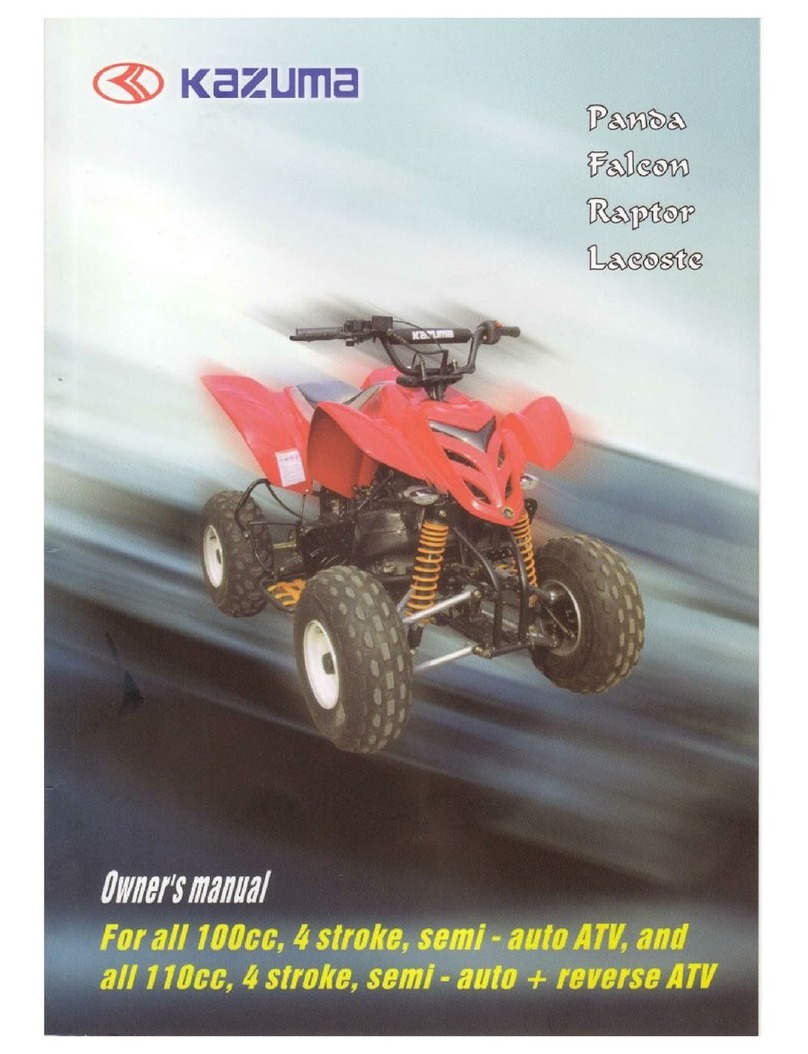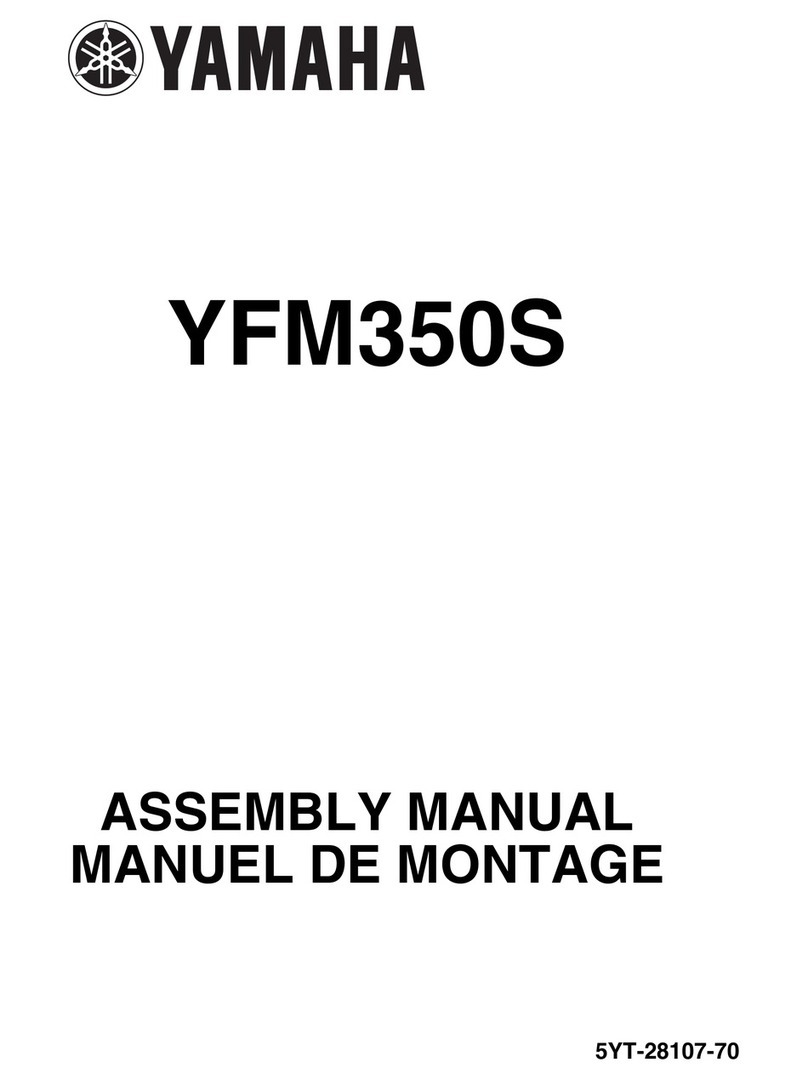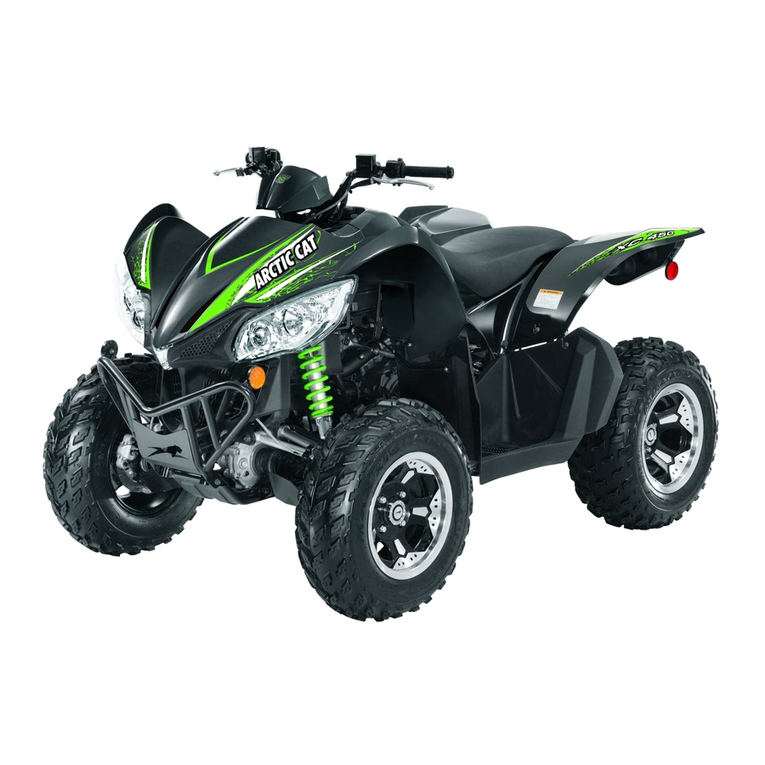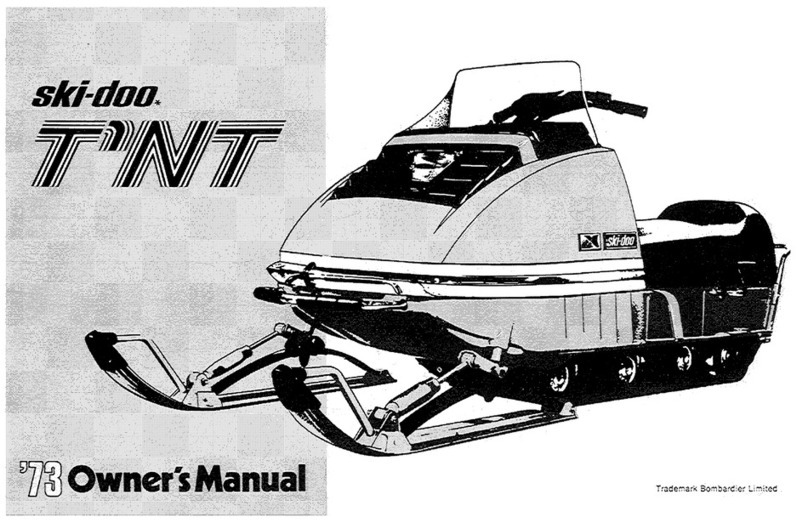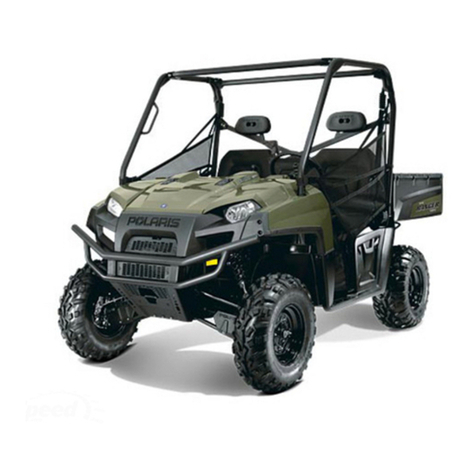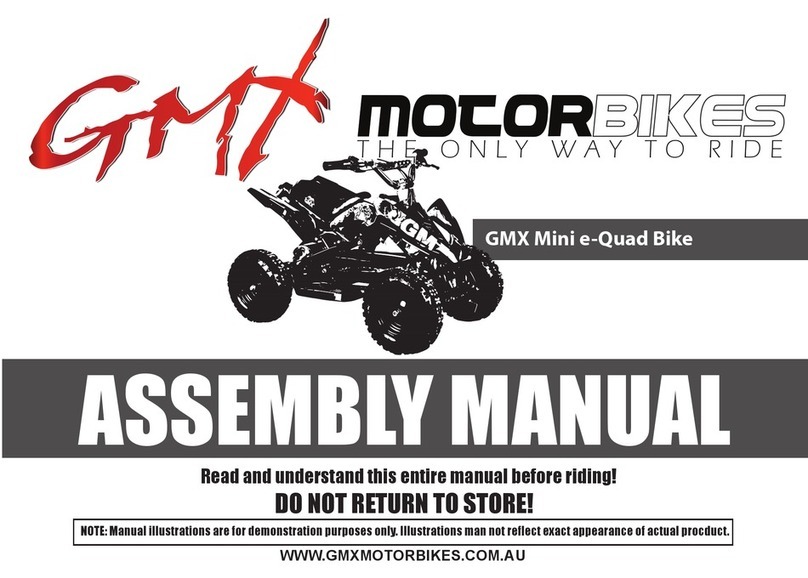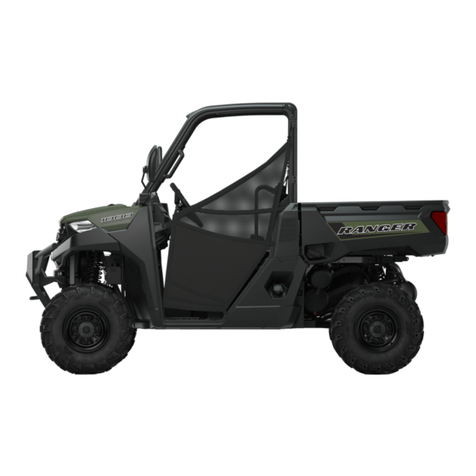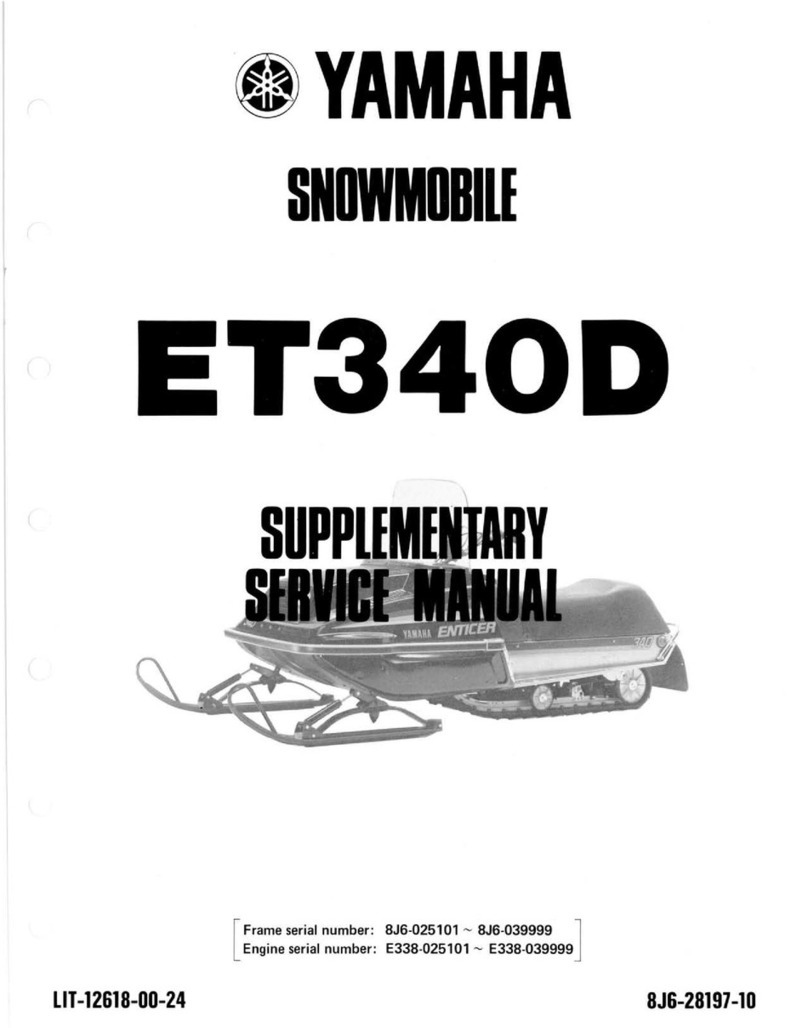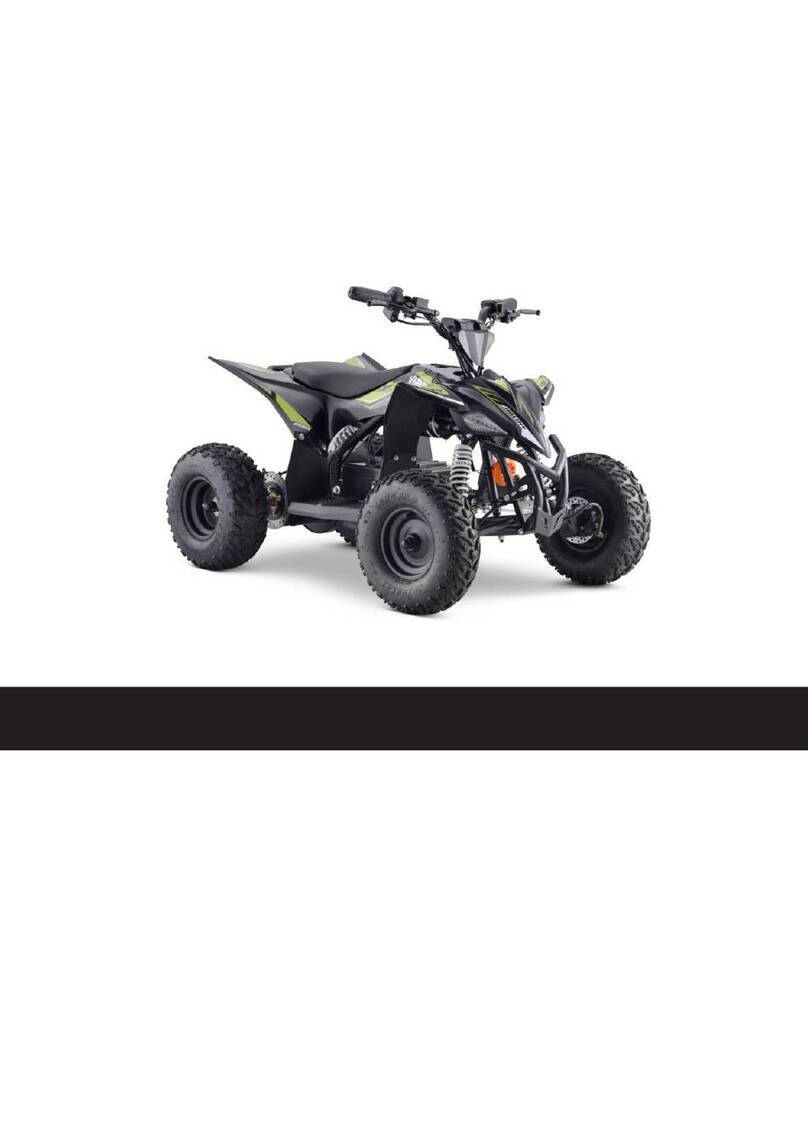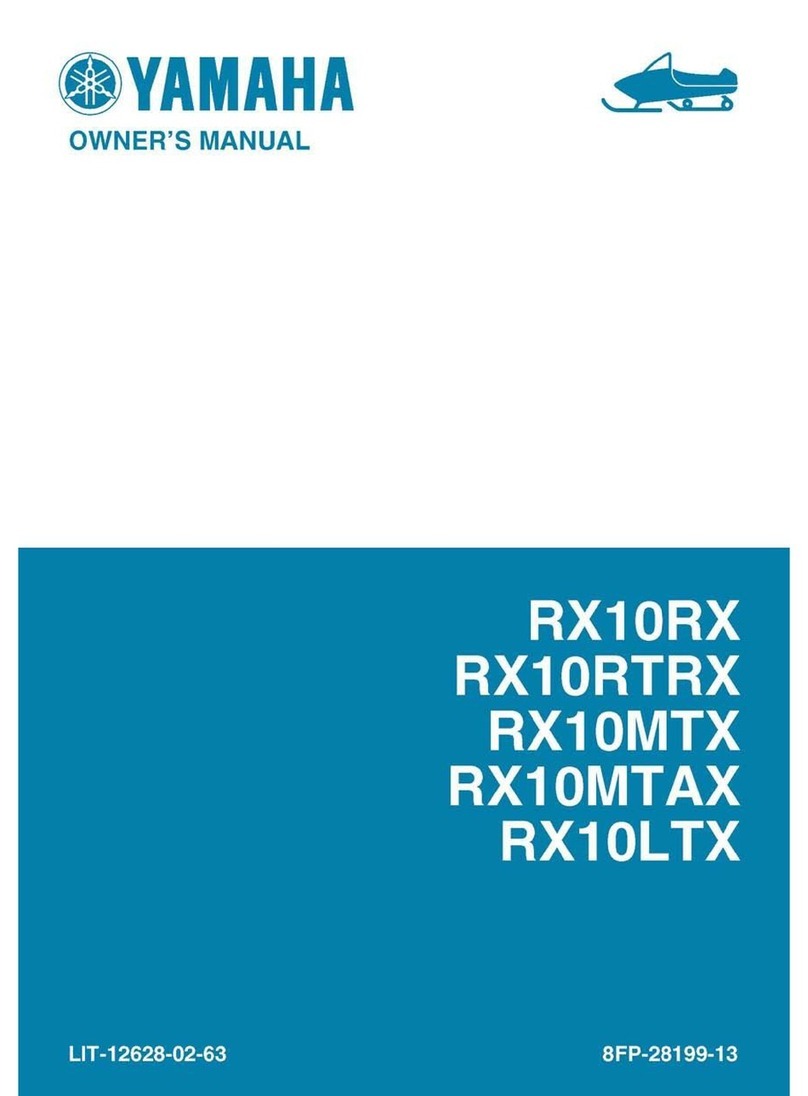EGL LYDA203E-6 User manual

WARNING: READ THIS MANUAL CAREFULLY!
EGL
MOTOR
OWNER’S
MANUAL-LYDA203E-6

2/ 46
INTRODUCTION
Thank you for your purchase LINGYING ATV LYDA203E-6 series.
This manual will provide you with a good basic understanding of the features and operation of this ATV.
This manual includes important safety information. It provides information about special techniques and skills necessary
to ride your ATV. It also includes basic maintenance and inspection procedures.
Please be close reading this manual, it will maximize the performance and lifetime of ATV.

3/ 46
IMPORTANT MANUAL INFORMATION
FAILURE TO FOLLOW THE WINNINGS AND COUTAINED IN THIS MANUAL CAN RESULT IN SERIOUS INJURY OR DEATH.
The safety alert symbol means attention!
Failure to follow warning instructions could result in severe injury or death to the machine operator, a bystander or
others who inspection or repairing the machine.
CAUTION: A caution shows special precautions that must be taken to avoid damage to the machine.
NOTE: A note provides key information to make procedures easier or much clearer.

4/ 46
CONTENTS
Important manual information…………………………2
Safety information………………………………………..4
Specification ………………………………………………7
Description ………………………………………………..8
Identification number records………………………….9
Control function………………………………………….10
Main switch……………………………………………….10
Left switch…………………………………………………11
Light switch……………………………………………….12
Choke………………………………………………………12
Throttle lever………………………………………………12
Clutch lever………………………………………………..14
Brake lever…………………………………………………14
Brake pedal………………………………………………..15
Front and rear brakes…………………………………….20
Brake fluid level……………………………………………20
Brake fluid leakage………………………………………..20
Fuel…………………………………………………………..21
Engine oil……………………………………………………22
Coolant reservoir…………………………………………..23
Operation…………………………………………………….25
Starting a cold engine……………………………………..25
To start out and accelerate……………………………….27
To decelerate………………………………………………..27
Engine break-in…………………………………………….28
Periodic maintenance and adjustment……………….28
Air filter element cleaning……………………………….30
Carburetor adjustment……………………………………31
Main technical specifications of the engine…………32
Operation and maintenance………………………………32
Troubleshooting of the engine…………………………33
Troubleshooting of cooling system……………………36
Electric fan wiring diagram………………………………37
Inspection of brake system………………………………37
Brake pads inspection………………………………………38
Clutch lever free play adjustment………………………39
Lubricating the drive chain…………………………………40
Brake pedal lubrication……………………………………40
Lubrication for a-arm………………………………………41
Rear axle system lubrication……………………………….41
Rear arm pivot lubrication…………………………………..41
Cleaning and storage……………………………………….42

5/ 46
SAFETY INFORMATION
ATV is not a toy, it can be hazardous to operate. An ATV handles difficultly from other vehicles. The accident such as collision and rollover will
happen, even while turning and riding back, on hill or over obstacles, If you fail to proper precautions.
Severe injury or death can result if you don’t follow below instructions:
1. Careful reading and complete understood this manual.
2. Never operates an ATV without proper training
3. Always obey the age recommendation. A child under 16 years old should never operate an ATV which engine size more than 90cc.
Never allow a child under age 16 to operate the ATV without adult supervision, and never allow continue to use ATV if the child doesn’t has the
ability to handle it safely.
4. Always avoid riding ATV on any sidewalks, steep slope, public street, dirt and loose surface.
5. Never operate ATV without wearing a proper helmet, and you should also wear the eye protection, gloves, boots, protective clothing as well.
6. Never consume alcohol or drugs before or during you operating this ATV
7. Never attempt wheelies, jumps, or other stunts
8. Never operate at excessive speed for your skills or the conditions, always go at the speed which is proper for the terrain, visibility, operating
conditions as your experience.
9. Always inspect your ATV each time you use it, to make sure it is satisfied with the safety condition. always adhere with the inspection and
maintenance procedures and schedule which described in this manual.
10. Always keeps the both hands and feet on the proper position while operating this ATV
11. Always drive slowly and great careful when operate the ATV on unfamiliar terrain, always be alert to changing the terrain condition when you
operating the ATV.
12. Never operate on excessively rough, slippery or loose terrain until you familiarized and can control ATV on such terrain.
13. Never operate the ATV on hills too steep beyond your skills, practices the smaller hills before you try to larger ones.

6/ 46
14. Always follow the proper procedures for climb hills as described in this manual, check the terrain carefully before you start up any hill, shift
your weight forward, never accelerate suddenly or sudden change the gears.
15. Always follow the proper procedures for go down hills and for braking on hills as described in this manual, also check the terrain carefully
before you start down hills, shift your weight backward, never go down a hill at high speed, avoid go down a hill at an angle that would cause
the vehicle to incline sharply to one side, go straight down the hill where possible.
16. Always follow the proper procedures for stall or roll backward when climbing a hill, to avoid stall, use the proper gear and maintain a stable
speed when climbing a hill. If you stall or backwards, follow the special procedure for braking described in this manual, dismount on the uphill
side or to a side if straight uphill. Turn on the ATV and remount.
17. Always check the obstacles before operate in a new area, never attempt to operate over large obstacles.
18.
Always be careful when skidding or sliding, learn to safely control skidding or sliding by practicing at low speed an on level smooth terrain.
19. Never modify the ATV though improper installation or use of accessories.
20. Always keep the safe distance with other vehicles.
POTENTIAL HAZARD
Improper handling of gasoline
WHAT CAN HAPPEN
Gasoline can catch fire and you will be burned.
HOW TO AVOID THE HAZARD
Always turn off the engine while refueling, don’t refuel immediately after the engine has been running long time and it is still very hot. Don’t spill
gasoline on the engine or muffler when refueling. Never refuel while smoking or nearby other stuffs which can be flammable.
When transporting the ATV with other vehicle, ensure it is kept upright and that the fuel cock is in the “off” position. Otherwise, fuel might leak out
of the carburetor or tank.

7/ 46
WHAT CAN HAPPEN
Gasoline is poisonous and can cause injuries.
HOW TO AVOID THE HAZARD
If you should swallow some gasoline or inhale a lot of vapor, or get some gasoline on your eyes, see doctor immediately, if gasoline spills on your
skin, wash with soap and water.

8/ 46
Specification
Model LYDA203E-6
Overall length 1700mm Max power 11.5Kw /6500±500 r / min
Overall width 1270mm Max speed ≥80km/h
Overall height 1020mm Max torque 17.5N.m /5500±500r / m
Seat height 740mm Engine oil type SF15W / 40 GB11121-1995
Wheel base 1160mm Engine oil capacity 1.1L
Ground clearance 160mm Fuel capacity 6.3L
Minimum turning radius Spark plug type D8TC
Net weight 195KG Lubrication Press/splash
Engine type 4-stroke,single cylinder, water cooled Front brake type disc
Displacement 250cc Rear brake type disc
Compression ratio 10.0
:
::
:
1 magneto Permanent magnetic
Ignition type CDI
Start system Electric
DESCRIPTION
NOTE:
The ATV you have purchased may slightly difference with these drafts or pictures of this manual.

9/ 46

10 / 46
Identification number records
Record the identification numbers information in below space will provide assistance when you order parts or for reference in case stolen.
Vehicle identification number:
Engine number:
Vehicle identification number is stamped on the frame.
Engine number is stamped on the bottom of engine left side.

11 / 46
Control function
Show a potential hazard that could result in severe injury or death.
Main switch
Functions of the each switch positions are as below:
ON:
The engine can be started only at this position
OFF:
All electric circuits are turned off, the key can be removed in this position

12 / 46
Left switch
1. Engine stop switch
2. Start switch
3. Turning light switch
4. Horn button
5. Light switch
6. Choke
Engine switch stop
Make sure the engine switch stop at the RUN position before starting the engine, the engine stop switch control the ignition and can be used to stop
engine at all times, especially in the emergency, the engine will not start while this switch is on the “OFF” position.
Start switch
The engine will be starting when this switch is pushed backward
Turning light switch
The left indicator will be working when push this switch to left side, conversely, right indicator working.

13 / 46
Light switch
Set the switch to “LO” position to turn on the low beam and the taillight.
Set the switch to “HI” position to turn on the high beam and the taillight
Set the switch to “OFF” position to turn off all lights.
Choke
The choke is used to help starting a cold engine.
Throttle lever
Once the engine is running , regulate the throttle lever will accelerate the engine, control the speed of engine machine by mutative the throttle
position, since the throttle is loaded with spring, the machine speed will down and return to the idle if hand removed from throttle.
1. Throttle
Before starting the engine, check the throttle to be sure it is work smoothly, also make sure it can be back to the idle once the lever released.
POTENTIAL HAZARD
Malfunction of throttle
WHAT CAN HAPPEN
The throttle could be hard to operate, will be difficult to accelerate or decelerate when you need to. It could cause a heavy accident.
HOW TO AVOID THIS HAZARD

14 / 46
Check the throttle lever before you start the engine, if it doesn’t work smoothly, check for the reason, correct the problem before riding the ATV.
Consult the professional expert or get assistance from dealer if you can’t figure out and solve the problem yourself.
Speed limiter
The speed limiter keeps the throttle from fully opening when the throttle lever pushed to maximum. Turning the adjustable screw limits to adjust the
engine power and increase or decrease the speed of ATV.
A: distance of ajustable screw no more than 1.2cm
Potential hazard
Improper operate the speed limiter and throttle
WHAT CAN HAPPEN
The throttle cable could be damaged, improper operate throttle could result in lose control, have an accident or injury.
HOW TO AVOID THE HAZARD
Always adjusts the speed limiter within safety distance.

15 / 46
Clutch lever
The clutch lever is located on the left handlebar, pull the clutch lever to handlebar to disengage
the clutch, and release the lever to engage the clutch. The clutch lever should be pulled rapidly and released slowly for smooth clutch operation.
Brake lever
The brake lever is located on the right handlebar. Pull it toward the handlebar to apply the front brake.

16 / 46
Brake pedal
The brake pedal is located on the right side of machine, push down the pedal to apply the rear brake
Parking brake lever
Use the parking brake when you have to park your ATV, especially on a slope
1 park brake locked position, move the parking brake lever to a direction apply the parking brake, 2 unlocked position, move the parking lever to
direction b to release the park brake.

17 / 46
Potential hazard
Improper operate the parking brake
WHAT CAN HAPPEN
The ATV could start moving unexpectedly if the parking brake is not applied before starting the engine. This could result in beyond control or a
collision.
The brake disc could overheat if you ride ATV without releasing the parking brake. it could loss of the brake performance and an accident might to
happen, and you will wear out the brake earlier.
HOW TO AVOID THE HAZARD
Always check the parking brake before starting the engine.
Always make sure you have released the parking brake before you ride ATV
Gear shift lever
This machine is equipped with a 4-speed forward with reverse transmission. The gear shift lever is located on the left side of engine and is used to
combination with the clutch when shifting.

18 / 46
Fuel tank cap
Remove the fuel tank cap by turning it counterclockwise as the cambered arrow of below picture showing.
Fuel cock
The fuel cock supplies the fuel from tank to carburetor .
The fuel cock has 3 positions.
OFF: fuel will not flow at this position, always turn the fuel cock to this position when the engine is not running.
ON: fuel can flows to the carburetor from tank, provides the normal riding when the fuel cock in this position
RES: this shows reserve, turn to this position if you run out of the fuel while riding. Then fill the tank in the first possibility.
Return the fuel cock to
“
““
“
ON
”
””
”
position after you filled the fuel.

19 / 46
Seat
To remove the seat, inset your hand between the rear of seat and the rear fender, pull the seat lock lever upward and pull up the seat at the rear.
To install the seat, insert the protecting of front seat into front seat holder and push down the seat at reat.
1. Protecting
NOTE: make sure the seat is securely fitted.

20 / 46
PRE-OPERATION CHECKS
Before ride this ATV, please check the below points:
Description Routine
Front and rear brake Check operation, lever free play, fluid level and fluid leakage.
Fill brake fluid if necessary
Clutch Check operation, condition and free play
Parking brake Check operation, condition and cable length
fuel Check fuel level, fill with fluid if necessary
Engine oil Check fuel level, fill with engine oil if necessary
Coolant reservoir Check coolant level in reservoir, fill with coolant if necessary
chain Check chain slack and condition, adjust if necessary
throttle Check for proper throttle cable and free play
Rims and tires Check pressure, wear, damage
Fittings and fasteners Check all fittings and fasteners
Lights and switches Check for proper operation.
Tire Check for the pressure and the wear condition
Potential hazard
Failure to inspect the ATV before operating
Failure to properly maintain the ATV
WHAT CAN HAPPEN
Increase the possibility of an accident or equipments damaged
HOW TO AVOID THE HAZARD
Always inspect your ATV each time to make sure the ATV is in safe operating condition.
Always follow the inspection and the maintenance procedures and the schedule.
Table of contents
